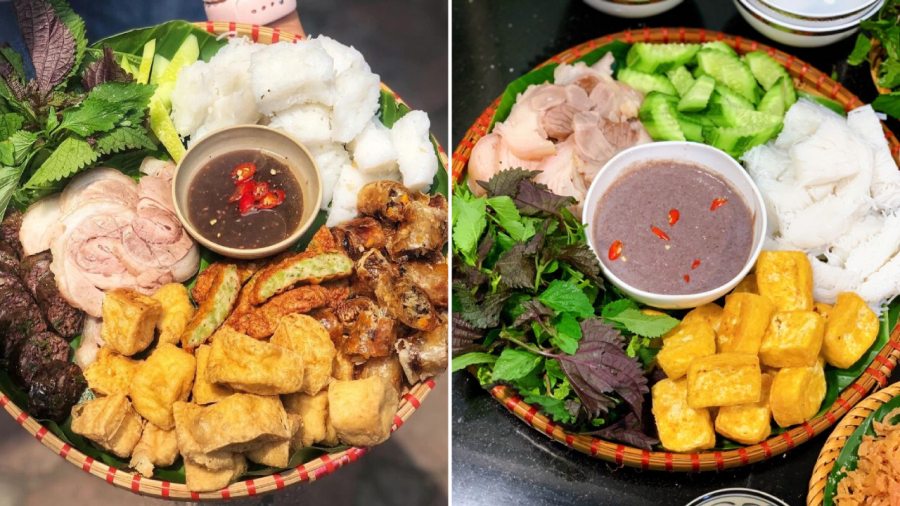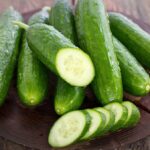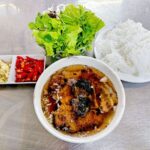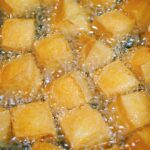Bún đậu, a beloved traditional Vietnamese dish, is easy to make and requires only a few simple ingredients.
The Original Hanoi Bún Đậu
The classic Hanoi Bún Đậu consisted of only three main components: rice vermicelli (bún), fried tofu (đậu rán), and fermented shrimp paste (mắm tôm). Connoisseurs of this dish insist that the tofu must be from Làng Mơ, made from high-quality beans with their skins removed. This results in soft, creamy, yet firm tofu with a superior flavor. The tofu is deep-fried to a golden crisp and served hot. For the best flavor, it is recommended to use pork fat for frying, as it imparts a delicious aroma and prevents oxidation, ensuring the tofu doesn’t burn.
Traditionally, the rice vermicelli used in Bún Đậu was the leaf-shaped variety, and it was cut into two or three pieces before being arranged on a platter.
One essential herb that cannot be missed is Láng basil, known for its small leaves and strong fragrance. As for the shrimp paste, it should be the dark purple variety from Thanh Hóa.
To prepare the shrimp paste dip, mix it with sugar, a few drops of white rum, and lime juice. Whisk vigorously until the paste becomes fluffy. The rum helps to neutralize the strong shrimp odor, while the sugar and lime balance the flavors.
Additionally, you can enhance the dip by adding a bit of hot pork fat straight from the frying pan. A few drops of cinnamon essence will also elevate the aroma of the shrimp paste.

Modern Hanoi Bún Đậu
Over time, the dish has evolved, and while the basic ingredients remain, modern interpretations have added several extras. Nowadays, it is common to find fried cinnamon pork patties (chả cốm), fried pork intestines (dồi chiên), and boiled pork knuckles (chân giò) included in Bún Đậu. These additional ingredients are fried just before serving to ensure crispness and then drained of excess oil. The pork knuckle is boiled with ginger and onion to eliminate any unpleasant odors and then cooled and refrigerated until needed. When ready to serve, the meat is sliced thinly.
Some establishments also offer fried spring rolls (nem rán) and sour spring rolls (nem chua rán), as well as boiled tongue, to accompany the dish. To prepare the tongue, it is boiled and then cooled before being sliced thinly.
As not everyone enjoys fermented shrimp paste, many places now offer a alternative dipping sauce: a sweet and sour fish sauce.
In addition to the traditional herbs, modern versions of the dish may include cucumber and basil to refresh the palate.
Hanoi’s Bún Đậu has spread across Vietnam, and in Ho Chi Minh City, it is often served with lettuce, basil, and cucumber. The ingredients are arranged on a platter, accompanied by the fluffy shrimp paste dip, with the level of spiciness adjusted to taste by adding chili peppers.
When preparing the shrimp paste, adding a bit of hot oil from the frying pan helps to kill any bacteria, making it safer for those with sensitive stomachs.
Bún Đậu is best enjoyed hot, with the tofu still crisp and golden, the cinnamon pork patties fragrant and slightly chewy, and the fried intestines rich and tender. The fresh herbs provide a refreshing contrast to the rich flavors, and when dipped into the sweet and savory shrimp paste, the dish comes alive with flavor.
The Best Bun Cha Ha Noi Has to Offer: 5 Mouth-Watering Destinations Worth the Splurge
When in Hanoi, indulging in a bowl of authentic bun cha is a must. This iconic Vietnamese dish, a harmonious blend of grilled pork, savory broth, and delicate rice noodles, is elevated to perfection at these five renowned establishments. Though they may come at a higher price, the exquisite flavors and exceptional dining experience are well worth the splurge. Prepare your taste buds for a culinary journey like no other!



































